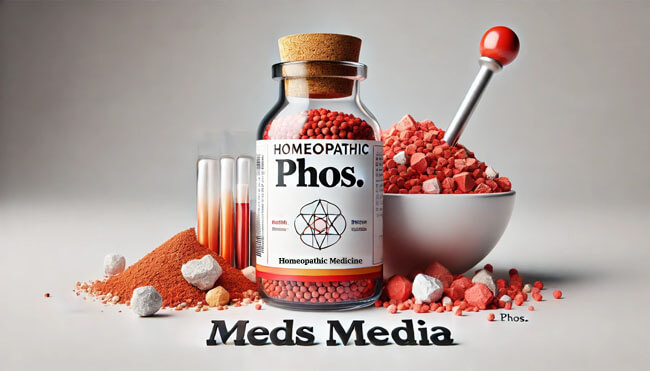Properties and Preparation:
Kali Phos, also known as Potassium Phosphate, is a vital homeopathic remedy with various therapeutic properties. It primarily affects the nervous system, making it a prominent nerve remedy. Kali Phos is commonly used to address conditions arising from nerve weakness, such as neurasthenia, mental and physical depression, and general prostration. The remedy is especially well-suited for young individuals dealing with sympathetic nervous system disturbances. Conditions triggered by factors like overwork, excitement, and worry may find relief with Kali Phos. It also demonstrates efficacy in cases of adynamia, decay, and gangrenous conditions. The preparation of Kali Phos involves a potentized dilution of Potassium Phosphate, rendering it safe and gentle for use.
Symptoms & Materia Medica:
Kali Phos, also known as Potassium Phosphate, is regarded as one of the most effective remedies for nerve-related issues. It is particularly suited for young individuals experiencing prostration, weakness, and exhaustion. The remedy is specifically indicated for conditions arising from a lack of nerve power, such as neurasthenia, mental and physical depression. It shows remarkable benefits in cases of disturbance in the sympathetic nervous system caused by factors like excitement, overwork, and worry. Additionally, Kali Phos corresponds to states of adynamia (lack of strength) and decay, including gangrenous conditions, which has earned it recognition in clinical practice. It is even recommended in the treatment of suspected malignant tumors and post-cancer surgery when the skin tightens over the wound during the healing process. Furthermore, Kali Phos aids in restoring the nervous system after periods of overwork, being considered a nerve nutrient.
This remedy has a wide range of applications, including relieving menstrual headaches, headaches in students that improve with motion, and brain-fag caused by mental strain and overexertion. Kali Phos is beneficial in stressful situations where a clear mind is needed, such as before exams or presentations. In children with night terrors and enuresis (bed-wetting), this remedy can be helpful. It is also indicated for girls experiencing delayed puberty and those with no menses until the age of 18, as it assists in initiating and increasing blood flow during menstruation.
Mind:
They may suffer from anxiety, characterized by a sense of unease and apprehension. Nervous dread can also be present, leading to a constant feeling of worry or fear. Additionally, they may feel lethargic and lacking in energy, experiencing extreme lassitude. Social interactions might become challenging as they develop a disinclination to meet people, preferring solitude instead.
The person may face great despondency concerning their business or work, leading to a reluctance to engage in conversations or discussions. Furthermore, nervousness, easy startle responses, and irritability could be prominent aspects of their behavior. The remedy may also address brain-fag, a condition marked by mental fatigue and an inability to work efficiently.
Moreover, individuals might experience hysteria and night terrors, causing distressing and unsettling nighttime experiences. Another potential effect is somnambulism, wherein the person unconsciously walks or performs activities during sleep. Memory loss might also manifest, making it difficult to recall past events or information.
Head:
An occipital headache, located at the back of the head, tends to alleviate after the person rises from a resting position. Vertigo, a sensation of dizziness and spinning, may occur when lying down, standing up, or gazing upward. Students and individuals facing fatigue might encounter headaches as a result. Interestingly, these headaches tend to find relief with gentle motion, suggesting a connection between movement and symptom improvement. Moreover, some headaches may accompany a feeling of weariness and emptiness in the stomach, adding to the complexity of the remedy’s impact on head-related issues.
Eyes:
Weakness of sight and loss of perception may be particularly noticeable, especially in individuals who have previously suffered from diphtheria. Drooping eyelids may occur, along with a sense of dryness and dullness in the eyes, potentially causing discomfort. Additionally, some individuals may experience sharp pains extending from the eyes to the temples, particularly noticeable in the morning. These eye-related symptoms highlight the remedy’s influence on visual health and suggest its potential role in addressing eye-related issues arising from different causes.
Ears:
Individuals may experience a persistent sensation of humming and buzzing in their ears, which can be quite bothersome. Furthermore, itching in the ears may become more pronounced when lying down, adding to the discomfort. Additionally, certain noises may be perceived within the ears, possibly resulting from nervous exhaustion. These ear-related symptoms indicate the remedy’s potential in addressing auditory issues and suggest its relevance in conditions related to the ears and the nervous system.
Nose:
Nasal disease accompanied by an offensive odor and fetid discharge, which can be quite unpleasant. Both fluent and dry coryza, a condition characterized by nasal congestion and discharge, may be experienced along with a cough. Additionally, the nose may become itchy and burn, further exacerbating the discomfort. In some cases, ulceration may develop in the nasal passages, adding to the complexity of the nasal symptoms. These manifestations suggest the remedy’s potential efficacy in addressing nasal ailments and related respiratory issues, offering relief to those affected.
Face:
livid and sunken appearance, accompanied by hollow eyes, which can indicate a state of weakness or fatigue. Moreover, a specific type of neuralgia may manifest on the right side of the face, causing severe pain. Fortunately, this neuralgic discomfort can be alleviated through the application of cold treatments.
Mouth:
Offensive and fetid breath, which can cause discomfort and embarrassment. Additionally, the tongue may appear brownish with a mustard-coated appearance, indicating possible changes in the oral mucosa. Excessive dryness in the mouth, particularly noticeable in the morning, may lead to discomfort and an unpleasant sensation. Furthermore, toothache may be experienced, often accompanied by easily bleeding gums and a bright-red seam on them.
Throat:
The throat-related symptoms linked to Kali Phos encompass a range of distressing conditions. One significant manifestation is gangrenous sore throat, a severe and potentially dangerous condition that can cause tissue decay in the throat area. Another notable effect is the paralysis of vocal cords, leading to difficulties in speech and voice control. Additionally, individuals may experience a sensation of fullness and constriction in the throat, often accompanied by constant hawking to clear the throat. Pain in the right tonsil is another symptom, characterized by a burning, raw, and sore sensation. Furthermore, inflammation and swelling of the throat and tonsils, along with the presence of white deposits, may cause discomfort and difficulty in swallowing.
Stomach:
Nervous feeling of emptiness at the pit of the stomach, which can cause unease and distress. Interestingly, the remedy can address seasickness without causing nausea, offering relief to those experiencing motion-related stomach discomfort. Moreover, individuals may encounter different types of eructations after meals, including bile, bitterness, emptiness, and food-related regurgitation. These symptoms can further contribute to stomach unease. On a positive note, Kali Phos has the potential to alleviate sour taste in the mouth, providing some respite from this unpleasant sensation.
Abdomen:
Diarrhea with a putrid odor may arise, triggered by fright and accompanied by feelings of depression and exhaustion. Additionally, some individuals may experience diarrhea while eating, adding to the discomfort. For those affected by dysentery, stools may contain pure blood, and the condition could be accompanied by delirium and abdominal swelling. In severe cases, the remedy might address cholera symptoms with rice-water-like stools. Prolapse of the rectum and nausea may occur during various activities, such as coughing, eating, menstruation, and pregnancy. Furthermore, vomiting could manifest in the morning or be triggered by coughing, eating, headaches, menstruation, or pregnancy. Nighttime can worsen abdominal pain, while griping pain in the hypogastrium might cause ineffective urges for a bowel movement.
Female Complaints:
Late or scanty menstruation may occur, particularly in pale, irritable, sensitive, and tearful females. Additionally, some women may experience a profuse discharge during menstruation, characterized by a deep-red or blackish-red color, thin consistency, and lack of coagulation, at times accompanied by an offensive odor. The remedy can also offer relief for those with feeble and ineffective labor pains during childbirth. Moreover, individuals might suffer from ovarian pain, especially on the left side, which can be alleviated by lying on the back and bending double, particularly during menstruation. Another notable manifestation is ovarian pain before sleep, adding to the complexity of female complaints.
Male:
Nocturnal emissions, commonly known as “wet dreams,” and diminished sexual power may be experienced, affecting the individual’s sexual functions and leading to a sense of physical and emotional fatigue. Moreover, after engaging in sexual activity, men may suffer from utter prostration, feeling completely drained and exhausted. Furthermore, frequent seminal emissions, often accompanied by erections, might become a prevalent issue for some individuals.
Urinary Organs:
Enuresis, commonly known as bed-wetting, and incontinence of urine may occur, leading to involuntary and inconvenient leakage. Additionally, individuals may experience bleeding from the urethra, indicating a potential concern that requires attention. Furthermore, the urine might appear very yellow, possibly indicating certain metabolic imbalances or dehydration. Moreover, after urination, some individuals may experience dribbling, causing further inconvenience and discomfort. A burning sensation in the urethra during and after urination can also be present, adding to the overall discomfort.
Respiratory:
In some individuals, asthma may worsen after eating, making breathing difficulties more pronounced during or after meals. Additionally, shortness of breath might be experienced while climbing stairs, indicating potential respiratory challenges during physical exertion. Furthermore, the remedy may address a cough characterized by yellow expectoration, possibly indicating the presence of respiratory mucus or infection.
Extremities:
Paralytic lameness may be experienced in both the back and the extremities, with exertion exacerbating the condition. Moreover, numbness may affect the upper and lower limbs, as well as the hands, fingertips, feet, and legs, potentially causing a loss of sensation in these areas. Cramps in the thighs, calves, and soles can cause distress and muscle tightness. Furthermore, the extremities may feel heavy, adding to the overall discomfort. The remedy also address hip joint disease, with accompanying pain in the hip and knee that finds relief through gentle motion. Additionally, individuals may experience tearing pains in various limb areas.
Generalities:
It is particularly beneficial after instances of shock and sudden blood loss resulting from injuries, aiding in the recovery process. Moreover, the remedy is indicated for discharges that emit a putrid and foul smell, offering relief from unpleasant symptoms. Swollen glands in the neck can be effectively addressed with this remedy, reducing discomfort and inflammation. Furthermore, individuals experiencing complaints aggravated by factors such as eating, overworking, worrying, receiving bad news, sustaining injuries, sexual excitement, mental and physical exertion, exposure to cold, consumption of cold drinks or milk, or early morning activities, may find relief with Kali Phos. On the other hand, the remedy tends to be more effective in conditions improved by warmth, gentle motion, rest, and nourishment.
Compare:
Comparatively, Kali hypophosph is indicated for debility accompanied by wasting of muscular tissue, as well as phosphaturia associated with general anemia or leucocythemia. It is also relevant for addressing the effects of excessive tea drinking. On the other hand, Genista, also known as Dyer’s Weed, is suitable for frontal headaches and vertigo aggravated by motion but improved by being outdoors and eating. It is helpful in cases of dry throat and itching eruptions on the elbows, knees, and ankles. Additionally, Genista promotes diuresis in dropsical conditions, aiding in the removal of excess fluid from the body.
For individuals experiencing extreme debility after severe illnesses and collapse, Macrozamia Spiralis offers potential relief. It addresses weariness without any identifiable cause or accompanying pains. Notable symptoms include boring pain at the vertex, persistent vomiting and retching throughout the night, inability to open the eyes, giddiness, and a sensation of coldness.
Furthermore, Zinc, Gelsemium, Cimicifuga, Lachesis, and Muriatic Acid (Mur ac) are also comparable remedies, suggesting that these remedies share certain overlapping indications and characteristics. These comparative remedies provide healthcare practitioners with additional options to consider when addressing various health conditions, tailoring treatment plans to suit individual needs and specific symptom profiles.
Complementary:
Remedies that follow well:
Antidotes:
Relationship:
Inimical:
Frequently Asked Questions (FAQ) about Kali Phos:
Q: What is Kali Phos used for in homeopathy?
A: Kali Phos is primarily used in homeopathy as a nerve remedy. It is indicated for conditions arising from nerve weakness, such as mental and physical exhaustion, neurasthenia, and depression. It also addresses states of adynamia and decay, gangrenous conditions, and is often considered in the treatment of suspected malignant tumors.
Q: How does Kali Phos influence the nervous system?
A: Kali Phos exerts a positive influence on the nervous system by restoring nerve power and strengthening its function. It is particularly beneficial for individuals experiencing symptoms of nervousness, irritability, brain-fag, and hysteria. The remedy aids in alleviating mental and emotional disturbances caused by stress, overwork, and worry.
Q: Is Kali Phos suitable for children and young individuals?
A: Yes, Kali Phos is especially well-suited for children and young individuals who exhibit symptoms of nervous weakness or disturbances. It is considered safe for use in all age groups, including infants, when prescribed by a qualified homeopathic practitioner.
Q: Can Kali Phos help with mental and physical exhaustion?
A: Yes, Kali Phos is highly effective in addressing both mental and physical exhaustion. It is particularly useful for individuals who feel weak, tired, and fatigued due to overexertion, stress, or prolonged mental strain.
Q: What are the conditions that can benefit from Kali Phos?
A: Kali Phos is beneficial for a wide range of conditions, including neurasthenia, mental and physical depression, nervous anxiety, night terrors, and headaches related to fatigue or stress. It is also indicated for certain gastrointestinal and urinary complaints, as well as female and male health issues.
Q: How is Kali Phos prepared in homeopathy?
A: Kali Phos is prepared through a potentization process, which involves successive dilution and succussion (vigorous shaking). The resulting homeopathic remedy is safe, gentle, and free from toxic effects.
Q: Are there any side effects of using Kali Phos?
A: When used according to the principles of homeopathy and in appropriate potencies, Kali Phos is generally considered safe and free from side effects. However, it is advisable to consult a homeopathic practitioner for proper dosage and guidance.
Q: Can Kali Phos be taken alongside conventional medications?
A: Homeopathic remedies like Kali Phos are generally safe to use alongside conventional medications. However, it is essential to inform your healthcare provider about all the remedies and medications you are using to avoid any potential interactions.
Q: How long does it take to see results with Kali Phos?
A: The response to Kali Phos may vary from person to person and depends on the individual’s specific health condition. Some people may experience improvement in symptoms relatively quickly, while others may require more extended treatment for a significant change.
Q: Is Kali Phos safe for long-term use?
A: When prescribed and supervised by a qualified homeopathic practitioner, Kali Phos is considered safe for long-term use. It is non-addictive and does not cause dependency. However, it is essential to reassess the treatment as the symptoms improve and adjust the dosage accordingly.
Books Reference:
- Homeopathic Materia Medica” by William Boericke – This comprehensive book provides detailed information on various homeopathic remedies, including Kali Phos.
- The Complete Homeopathy Handbook” by Miranda Castro – A practical guide to homeopathy, this book includes valuable insights into using remedies like Kali Phos for specific health issues.
- Materia Medica with Repertory” by Dr. William H. Burt – An authoritative text containing in-depth descriptions and therapeutic applications of homeopathic medicines.
- The Prescriber” by J. H. Clarke – A classic reference for homeopathic prescribers, offering guidance on selecting remedies like Kali Phos for different ailments.
- Desktop Guide to Keynotes and Confirmatory Symptoms” by Roger Morrison and David A. Johnson – This book provides quick and concise information on key symptoms and characteristics of remedies, including Kali Phos.
Please note that the information provided here is for informational purposes only and should not replace professional medical advice. It is always recommended to consult qualified homeopathic doctors for proper diagnosis, guidance on the use of KALI PHOSPHORICUM and individualized effective homeopathy treatment.
* Related Homeopathic Medicine *
KALI BICHROMICUM
PHOSPHORICUM ACIDUM
STRYCHNINUM PHOSPHORICUM
Similar Posts
Zincum Picricum Homeopathic Medicine & Personality | Uses, Benefits & Indications
Zincum Phosphoricum Homeopathic Medicine & Personality | Uses, Benefits & Indications
Zincum Iodatum Homeopathic Medicine & Personality | Uses, Benefits & Indications
Zincum Bromatum Homeopathic Medicine & Personality | Uses, Benefits & Indications
Zea Homeopathic Medicine & Personality | Uses, Benefits & Indications
Zincum Aceticum Homeopathic Medicine & Personality | Uses, Benefits & Indications
Zincum Cyanatum Homeopathic Medicine & Personality | Uses, Benefits & Indications
Zincum Muriaticum Homeopathic Medicine & Personality | Uses, Benefits & Indications
Zincum Oxydatum Homeopathic Medicine & Personality | Uses, Benefits & Indications
Zincum Sulphuricum Homeopathic Medicine & Personality | Uses, Benefits & Indications

Phosphorus Homeopathic Medicine & Personality | Uses, Benefits & Indications
Causticum Homeopathic Medicine & Personality | Uses, Benefits & Indications

Top Global Homeopathic Medicine Manufacturers

Top renowned Homeopathic research institutes worldwide


